Tryon Daily Bulletin is an American, English language daily newspaper based in Tryon, Polk County, North Carolina; it also serves parts of Spartanburg and Greenville counties in South Carolina. Known as "The World’s Smallest Daily Newspaper", it was established in 1928 by Seth Vining Sr. It had a readership of 4,250 in 2019 and its website had 30,000 visitors.

Greer Downtown Historic District is a national historic district located at Greer, Greenville County, South Carolina. The district encompasses 40 contributing buildings constructed from ca. 1900 to ca. 1940, with the majority constructed between 1910 and 1930 in the central business district of Greer. They are largely two-story brick commercial structures. Notable buildings include the First National Bank of Greer, Planters Savings Bank, R. L. Merchant Building, Bailey Building, Bailes-Collins Department Store, and Davenport Building.

National Loan and Exchange Bank Building, also known as the Barringer Building, is a historic bank and office building located at 1338 Main Street, Columbia, South Carolina. It was built in 1903, and is a 12-story, steel frame building faced in brick and stone. It measures 184 feet high and is considered Columbia's first skyscraper. The building was owned by the Barringer Corporation from 1953 until 1974.

Whitehall is a historic home located at Greenville, South Carolina. It was built in 1813 as a summer residence by Charlestonian Henry Middleton on land purchased from Elias Earle. Whitehall served as Middleton's summer home until 1820. It is a simple white frame structure with shuttered windows and wide first and second story galleries, or piazzas, in the Barbadian style.
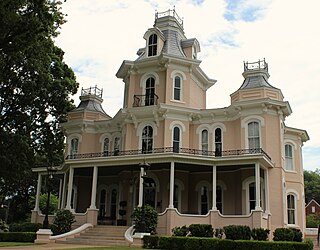
The Lanneau-Norwood House is a historic house in Greenville, South Carolina, built c. 1877 by Jacob W. Cagle (1832–1910) for capitalist Charles Henry Lanneau II (1834-1913).
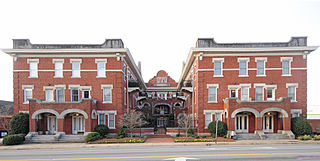
Davenport Apartments is a historic apartment building located at Greenville, South Carolina. It was built in 1915–1916, and is a three-story, "U"-shaped, brick building. It consists of a large rectangular section in the rear with two smaller wings that extend from the rear block to the street. The front façade features two one-story porches with stone elliptical arches and brick pillars.

American Cigar Factory, also known as Stone Manufacturing Company, is a historic factory building located at Greenville, South Carolina. It was built about 1902, and is a four-story, rectangular brick building with segmental arch openings. It has a low-pitched gable roof with a projecting eave and floors supported by wooden posts.

Greenville Gas and Electric Light Company, also known as Duke Power Steam Plant, is a historic power plant located at Greenville, South Carolina. The two brick vernacular Victorian style buildings were built about 1890. The larger building served as a coal-fueled, steam-powered electric generating plant, and is a one-story, rectangular building with round arched window and door openings. The second building is a two-story rectangular building originally used as offices for the power company. They were originally owned and operated by the Greenville Gas and Electric Light and Power Company, then sold in 1910, to a company that later evolved into Duke Power Company.
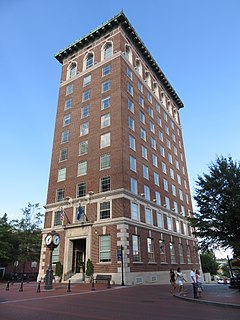
Chamber of Commerce Building, also known as the North Greenville College Building, is a historic office building located at Greenville, South Carolina. It was built in 1925, and is a ten-story rectangular brick sheathed steel frame building. The Chicago School style skyscraper consists of a two-story base with Neoclassical detailing, a seven-story shaft, and a roof story that features tall arched windows and a brick and stone frieze with transoms and stone panels.

Working Benevolent Temple and Professional Building is a historic office building located at Greenville, South Carolina. It was built in 1922, and is a three-story, steel frame brick building. The building housed offices for African-American doctors, lawyers, dentists, a newspaper, and insurance firms and housed the first black mortuary in Greenville. The temple was also the center for Greenville's civil rights activities during the 1960s.

Imperial Hotel, also known as Hotel Greenville, is a historic hotel building located at Greenville, South Carolina. It was built in 1911–1912, and is a seven-story, U-shaped skyscraper with a buff-colored brick veneer over a steel frame. It was originally a 90-room hotel, and expanded by 1930 to 250 rooms. The hotel closed in the early 1970s, but this establishment is still used as a nursing home for disabled people 55 and over. An adjacent parking garage was demolished in the 1980s.

Greenville County Courthouse, also known as Greenville Family Courts Building, is a historic courthouse located at Greenville, South Carolina. It was built in 1918, and is a Beaux-Arts style brick and concrete building with terra cotta trim. The building consists of a three-story front section, with an eight-story tower behind. The building served as the courthouse for Greenville County until 1950 when the court was moved to a new building. The Family Court of Greenville County was located then in the building and remained there until 1991.
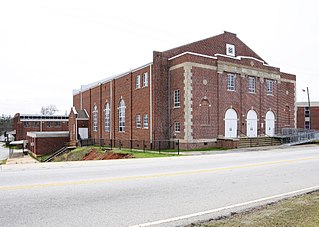
Parker High School Auditorium is a historic high school auditorium located at Greenville, South Carolina. It was built in 1938 with funding provided by the Works Progress Administration. It is a Classical Revival style 7500 square foot rectangular brick building with a front gabled roof. It is the last remaining building from the largest WPA school project in South Carolina.
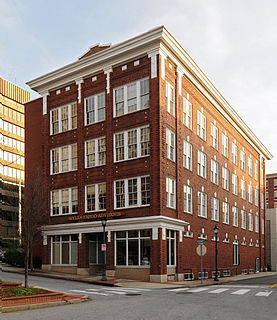
Carolina Supply Company is a historic commercial building located at Greenville, South Carolina. It was built in 1914, and is a four-story, brick building in a utilitarian Renaissance Revival style. The building housed a textile and industrial supply company that supplied mills with equipment and supplies. The building now houses Wells Fargo Bank.

Gilfillin and Houston Building also known as Greenville Bakery and Greenville Auto Sales, is a historic commercial building located at Greenville, South Carolina. It was built in 1915, and is a two-story, brick commercial block. The building's façade is organized into two storefront sections and features a curvilinear brick gable and parapet embellished with a central, circular, limestone-keyed and brick-surrounded cartouche containing the letters "G" and "H" intertwined.

Brushy Creek, also known as Vardry McBee House and Alexander McBee House, is a historic home located at Greenville, South Carolina. It was built about 1836 as a 1 1/2-story, frame farmhouse. In 1924, the house was expanded with the addition of a one-story frame room, that incorporated the formerly separate kitchen into the house itself. Further renovations were made in 1938–1939 and 1951. Also on the property are a log barn, a brick shed, a well house, and the ruins of a grist mill. It was the home of Vardry McBee (1775–1864), prominent 19th-century businessman, entrepreneur, and delegate to the Secession Convention of Greenville District known as the “Father of Greenville,” and his son Alexander McBee (1822–1897), prominent 19th-century businessman, banker, and state representative of Greenville District.

Hampton–Pinckney Historic District is a national historic district located at Greenville, South Carolina. It encompasses 70 contributing buildings in a residential section of Greenville. The houses date from about 1890 to 1930, and include Italianate, Greek Revival, Queen Anne, various bungalows, and examples of Gothic Revival and Colonial Revival design, as well as vernacular forms. The oldest house in the district is the McBee House.

Col. Elias Earle Historic District is a national historic district located at Greenville, South Carolina. It encompasses 74 contributing buildings in a middle-class neighborhood of Greenville. The houses primarily date from about 1915 to 1930, and include Neoclassical, Colonial Revival, Tudor Revival, and bungalow styles. The district was originally part of the estate of Colonel Elias Earle, a prominent early-19th century Greenville citizen. The Earle St. Baptist Church is located in the district.

West End Commercial Historic District is a national historic district located at Greenville, South Carolina. It encompasses 15 contributing buildings in Greenville's second "downtown." The commercial buildings primarily date from about 1880 to 1920, and include examples of Victorian commercial architecture. Notable buildings include the American Bank, Alliance and Mills & McBayer Cotton Warehouses, Indian River Fruit Store, Pete's Place, Bacot's West End Drug Store/Stringer's Drug, Furman Lunch, and Greer Thompson Building.
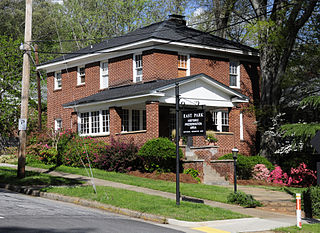
East Park Historic District is a national historic district located at Greenville, South Carolina. It encompasses 121 contributing buildings, 1 contributing site, and 3 contributing structures in a middle- / upper-class neighborhood of Greenville. The houses date from about 1908 to 1950, and include Neoclassical, Colonial Revival, Tudor Revival, Victorian, American Foursquare, Prairie Style, and bungalow styles.






















